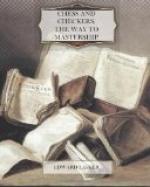III
GENERAL PRINCIPLES OF CHESS STRATEGY
In reading the chapter on “Elementary Tactics” the beginner will have obtained a fair idea of the value of the different pieces and he will have gained an insight into the possibilities of their cooperation. However, the fundamental principle of Chess strategy, the method of developing the inherent powers of the men so that they may be able to do all the work possible for them, will still be a secret to him.
At the beginning of the game the Knights are the only pieces which are able to move, and consequently the other pieces are worthless until openings have been created for them by Pawn moves. Now, the first thing the beginner should try to keep in mind is that only such Pawn moves can be good as open lines for their fellow pieces or obstruct lines of opposing men. The reason is this:
In any hand to hand fight evidently that player will get the better of it who has more pieces ready for action on the battlefield. When examining the typical positions discussed in the previous chapter the fact will strike the observant reader that the winning player always has a decided superiority of forces at his disposal where the actual fight is going on, so that in some cases he can even sacrifice a great amount of them and still have enough left for the final onslaught against the King. The same holds good in combinations where lesser objects than the King are fought for; the player who has more pieces ready to take part in the struggle will emerge victorious; the player who attacks with less pieces than the opponent has on the spot for defense, cannot hope to succeed.
The important point, therefore, is to place the pieces so that they will be in readiness for concentration on whatever part of the board they are needed.
Moreover, it will be important to place the pieces on such favorable squares in the shortest possible time—meaning with the smallest number of moves—as wasting moves on maneuvers which do not further the mobilization of the troops will give the opponent an opportunity to gather a superior force somewhere on the board and make an attack with the best chance in the world to succeed before reinforcements can be brought up.
With this aim in mind the beginner will readily see that it is by no means immaterial which Pawn moves are made in the opening. The fact that a Pawn move opens an outlet for a piece is not sufficient. If possible Pawn moves will have to be found which enable the development of more than one piece for they will lead to an advantage in the mobilization unless the opponent, too, hastens the development of his pieces by equally good Pawn moves.




